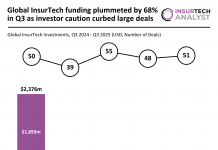Against the backdrop of rapid technological advancements and the evolving needs of the InsurTech landscape, hyperexponential hosted a meeting of the minds to discuss the future of underwriting. In a sector that has been chastised for its lack of mobility and agility in regard to change, the webinar discussed the possibility that it is now time to enter a new era – the age of Underwriting 3.0.
The panel was led and moderated by Tom Chamberlain, VP Customer and Consulting, hyperexponential, it also featured a handful of distinguished guests from the space. Bevis Tetlow, CEO Imaginera Limited, Ben Cannon, Underwriting Managaer, General Aviation, Corporate & Speciality, Allianz Global, as well as Chris Drew, Chief Actuarial Officer, Volante.
The esteemed group looked to unpack a recent report carried out independent research firm Coleman Parkes, who surveyed 245 underwriters working in Speciality and Commercial insurance across US and Uk on behalf of hyperexponential.
At the centre of this study was the current state of underwriting. More specifically, it aimed to identify how legacy technologies and processes impact the day-to-day for companies working within the sector.
The study was pushed out by hyperexponential, who wanted to uncover whether or not the influx of new technologies which are taking over the realm – in the form of Generative AI, more advanced predictive models, as well as the automation of processes – are laying the foundation for a new chapter of underwriting.
Chamberlain explained, “We wanted to see if the promises of digital innovation had laid the foundation for Underwriting 3.0.”
However the study showed that work still desperately needed to be done. “Insurers need to embrace change. 97% of Speciality and Commercial insurers are either investing in pricing or underwriting technology today, or planning to in the next 12 months. So there is clearly an appetite for it. However, we are seeing that 1 in 2 transformations aren’t achieving what’s promised,” explained Chamberlain.
Clearly then, the need for a dramatic transformation of the underwriting sector is apparent, with a clear necessity to move into the future. But what is the vision for Underwriting 3.0?
Cannon gave his view on that exact question, explaining, “My vision of Underwriting 3.0 is looking at how we can bring together the underwriting process which has become more and more complex and manual, so that we can combine it with underwriting data for ultimately faster and more accurate underwriting decisions on a day-to-day basis.”
“I think underwriters would in general be crying out for process improvements, but at the same time they want to make good decisions, so we need to make sure that all the data is being pulled in efficiently to help make those decisions,” he explained.
Drew concurred, expressing that streamlining the processes and the entire underwriting procedure needs to be the target. He said, “A lot of it is about operational streamlining. Making sure that data is captured right from the start, so it is readily available for everybody to use.
“Whether that’s in pricing, or whether that’s in policy documentation, or submission management. It’s building these data bases that talk to eachother and that people have access to. But also that collaboration between the different teams, the actuaries, the underwriters, the claims teams. It’s about managing that whole ecosystem and making sure that everyone has access to all the information they want right from the start.”
Will actuaries and underwriters need to collaborate in the future?
The collaboration between actuaries and underwriters was also discussed fervently when debating the future of underwriting. The study revealed that 53% of underwriters wold like to collaborate more with actuaries to improve processes.
In Cannon’s eyes, this eye-opening stat clearly painted a picture of the current system. He explained, Collaboration is the word here, we have to remember that we are all pulling in the same direction, whether it’s on the actuarial side or the underwriting side. If we don’t then that has to be addressed. Better tech, better data, and better processes will all lead to better collaboration so that we can take away those pain points.
“Ultimately, on both sides you can focus on getting the job done and the outcomes that we want. Having a greater understanding of both roles is helpful. Bringing actuarial colleagues into the line of business so that it isn’t just all about numbers, will give us a better understanding of products, and of how the dynamics of the marketplace work. Similarly, it is important that underwriters gain a greater understanding of how an actuary will look at a product.”
The current state of underwriting
The discussion also moved onto the current state of underwriting – and perhaps shed more light on the importance of this transition to underwriting 3.0. The existing landscape, rooted in traditional methods and outdated systems, has been heavily scrutinised for its limitations in addressing the complexities of modern risks, the survey’s findings were no different.
According to the report, a staggering 82% of underwriters are now concerned about not having fit-for-purpose models. This fear that is growing within the industry now means it is imperative to move with the times into the modern world of data.
Speaking on the idea of technology correcting these issues, Tetlow said, stats speak for themselves. A lot of this is because classes of business are often pretty complicated and have different needs. In the past, legacy technology probably hasn’t had the flexibility to cope when new processes have been added. I think there is lots of potentially exciting ways technology can help in the future – not a lot of it is very sexy – but it comes back to removing that administrative friction. Then we can help people bring their teams together with better tools, more effectively, and therefore they can really leverage multiple new data sources to provide new underwriting insights which will in turn provide better loss ratios.
What are the actionable steps needed to access the new era of underwriting?
The webinar moved onto what actionable steps could be taken to reach the next version of underwriting. in the eyes of Cannon, underwriters are at the heart of this transformation, as he explained that they are the ones using the tools on a day-to-day basis – meaning that they need to be listened to from the formation of this new era.
Drew also gave his viewpoint, explaining that it in his eyes, it is a “false economy” to not spend the money on what is going to make these 1-2% gains, as he called for companies to invest in the future of underwriting 3.0.
The path to embracing the new era of underwriting, Underwriting 3.0, demands a concerted effort rooted in strategic collaboration and investment. Recognizing the pivotal role of underwriters as the linchpin of this transformative journey, it becomes imperative to heed their insights and experiences in shaping the evolution of underwriting tools and methodologies.
The roadmap to this next phase requires a fusion of technological innovation, industry expertise, and a commitment to proactive investment—a collective effort that will undoubtedly propel the insurance industry into a future defined by precision, efficiency, and resilience.
If you want to listen to the full discussion hosted by hyperexponential, click here.
Keep up with all the latest FinTech news here.
Copyright © 2024 FinTech Global










